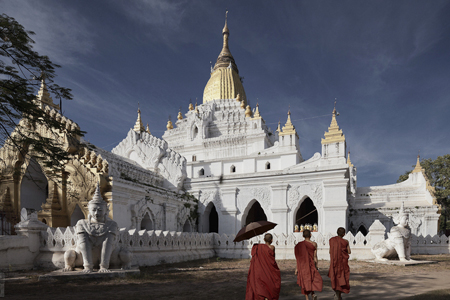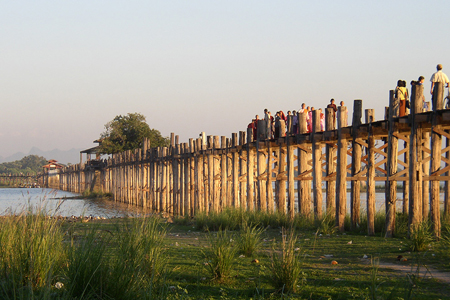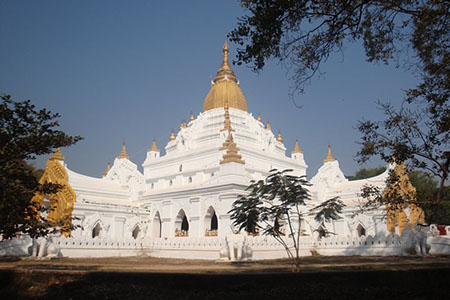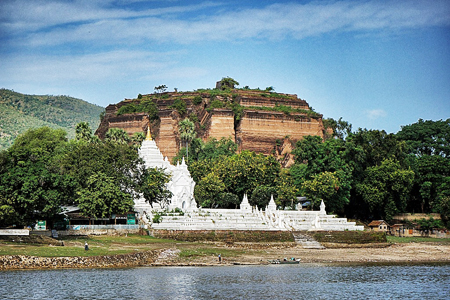About 7 miles toward the north of Mandalay, Amarapura, which is well known as the City of Immortals, is one of the noticeable former cities of Myanmar that worth you a day visit on a Mandalay day trip.

History of Amarapura
When Bodawpaya ascended the throne he founded Amarapura and moved his capital from Innwa. His grandson and successor, Bagyidaw, shifted the capital back to Innwa in 1823. Tharawaddy (1837-46) who succeeded Bagyidaw took the capital back to Amarapura and it remained the seat of the Myanmar king until Mindon established the new capital at Mandalay. The city is laid out in a perfect square with a moat surrounding the brick walls. There were twelve gates, three on each side. Above the gates were wooden pavilions and the banks of the moat were properly lined with bricks.
As most of the palace buildings were dismantled and removed to Mandalay there is very little left of the citadel. Even the fort walls have since been pulled down to quarry bricks for the construction of roads and railway tracks. The remains of only two masonry structures, the Treasury and the Record Office are still to be seen within the city. At each corner within the fort stands a pagoda constructed at the time of founding the city.
Best Things to Do & See in Amarapura & Around
U Bein Bridge
To the south of the city is the Taungthaman Lake which is spanned by an ancient wooden bridge built by U Bein, the Mayor. At a length of 1.2 km, U Bein Bridge is the longest teak bridge in the world. Undoubtedly, this is the most beautiful attraction in Amarapura. The best time of the day to visit U Bein Bridge is in the late afternoon when the sun is slowly going down and immerse everything in golden light.

Kyauktawgyi Pagoda
At the far end of this bridge is the Kyauktawgyi pagoda built by King Bagan in 1847 on the model of the Ananda Temple at Bagan. It closely resembles the Ananda in exterior form but it falls short of the latter in construction and interior decoration. Unlike the Ananda which has perfect vaulted roofs, the Kyauktawgyi has wooden rafters and beams which account for the weakness of the structure. There is only one principal image carved out of a single block of Sagyin marble. The walls in the east and south porches are adorned with paintings depicting many religious buildings erected by the donor and other kings in different parts of the country, and scenes from contemporary Myanmar life. An unusual form of architecture is exhibited by the Nagayon, a vaulted pagoda guarded over by a huge dragon within the city.

Pay Solemn Visit to The tombs of Bodawpaya & Bagyidaw
The tombs of Bodawpaya and Bagyidaw are located inside the city. The chief queen of Tharawaddy, also known as Shwebo Min, and her daughter built two wooden monasteries in 1843 to the north-east of the city. They were dedicated as the residence of U Nyeya, the Archbishop. Subsequently, the princess became the chief queen of Mindon and her preceptor was raised to the dignity of the Head of the Buddhist Church. Owing to the rank and wealth of the donors and to the high ecclesiastical status of the occupant the resources of Myanmar art were lavished on them. Unfortunately, both the monasteries were destroyed during the second world war and a few specimens of architectural motifs that could be retrieved are now deposited in the cultural museum at Mandalay.
Shwekyetyet and Shwekyet-kya Pagodas
On the left bank of the Ayeyarwady, opposite Sagaing is two twin pagodas the Shwekyetyet and Shwekyet-kya reputed to have been built by a king of Bagan in the 12th century. Lower down lies the Thabyedan Fort built during Mindon’s reign with the assistance of Italian and French engineers for the defense of Mandalay. It was, however, not put to effective use as the garrison there was disbanded when the British fleet was allowed to advance without opposition after Minhla fort was stormed soon after the outbreak of the third Anglo-Myanmar war.
Patodawgyi Pagoda
Near the south wall, outside the city, is the Patodawgyi Pagoda built by Bagyidaw in 1820. It is of imposing height and the lower three terraces are decorated with marble slabs with scenes from the Jataka stones carved in bold relief. The history of the pagoda is recorded on a big inscription stone and a large bronze bell dedicated to the pagoda is installed within its precincts.


